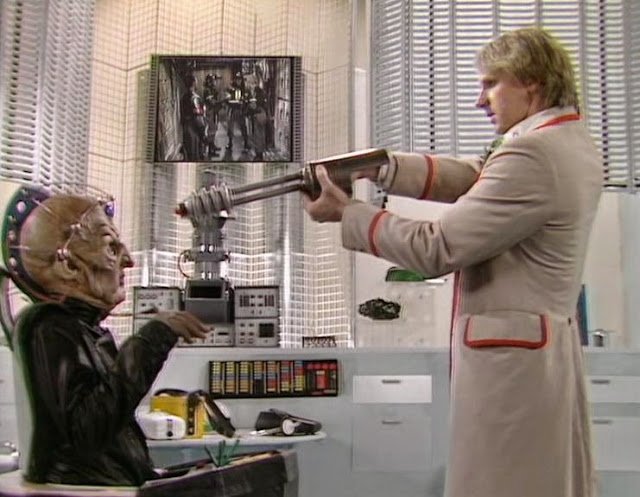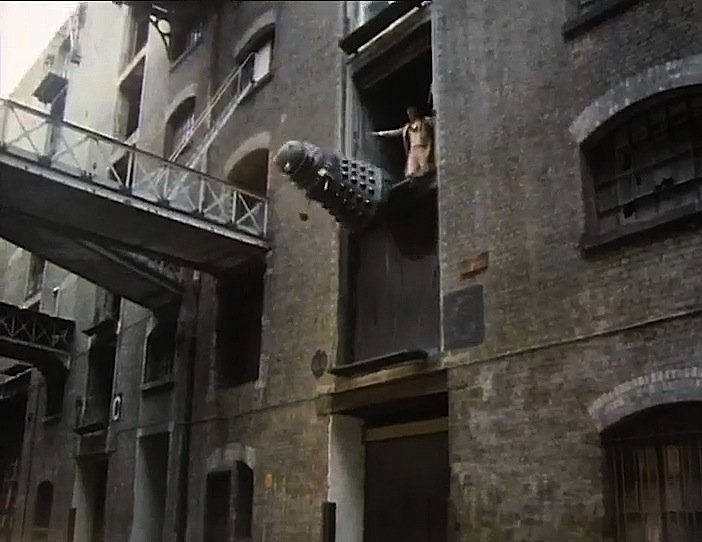Resurrection of the Daleks is Eric Saward’s belated novelisation of his own 1984 script for Peter Davison’s Fifth Doctor. On broadcast, a hair before my eighth birthday, I was gripped: the Daleks and Davros back after five years, the uncased mutant, the Doctor as executioner, the clips from previous stories, Seaton pleading like a frightened child as his face rots and bubbles.
Decades later and I see it for the slickly produced knock off of Earthshock it is: an entertaining, but sketchy morass of good ideas tangled in loose threads. The Daleks hide samples of the lethal Movellan virus 2606 years down a time corridor on Earth, which they’re also planning to invade, while trying to liberate Davros so he can find a cure the virus, while they attempt to capture the Doctor, whom they’ve copied so they can feed his brain patterns into their duplicate, so it can assassinate the High Council of the Time Lords. Stien is a duplicate and a double agent but he acts in character even when alone, and Dalek troopers are duplicates because… reasons. Either the Daleks need more planning meetings or the Doctor Who production office needed a whiteboard. I shan’t say much more about the story itself, but you can read our illustrious editor’s excellent (I’d prefer ‘sublimely unparalleled’ – Ed.) review of Season 21 here.

Saward’s novelisation – postponed decades, I assume by his ill-feeling toward the BBC and contractual wranglings with the Terry Nation estate – is a solid and very readable adaptation of the original script (Paul Scoones of the New Zealand fan club penned an unofficial novelisation 20 years ago). It lacks the cosy charm of 20th Century Target adaptations (particularly those by the sainted Uncle Terry), but the unremittingly grim original doesn’t boast much cosiness. Commendably, there are a variety of educational references to the history of Shad Thames, art, and architecture.
Saward tells the story in traditional Target tell-don’t-show style, but I found his narrative voice and asides to be intrusive even to the point of spoilerish: ‘Little did they know it would be the last time they would hear him speak those words’ or ‘Neither did she know that, when the cruiser arrived, there would be a terrible battle, followed by a visitation from the worst house guests in the universe…’ or ‘Now, here’s a thing.’ I never really felt a part of the action or privy to the characters’ private thoughts.
There are moments to enjoy. Saward gives us an imaginative tour inside the TARDIS, which boasts art galleries, studios, a wardrobe that is a ‘huge cavern lined with several oceans’ (hmm) of clothes, an ‘Explosion Emotion Chamber,’ gyms, and the inevitable library. There’s also a cinema with a roster of classic films I suspect are all favourites of the author. The problem with this passage is that, while imaginative, it’s all delivered by a very subjunctive narrator, as things Stien might have seen had he bothered to look around. None of it affects the story one jot.
There’s some sly humour. Tegan and the Doctor run along Shad Thames and Tegan asks him to slow down because she’s wearing heels. Colonel Archer’s line, ‘It seems we die with dignity’ will surely raise a smile from anyone who recalls Del Henney’s… committed swansong in the original. Saward adds a bizarre, Adamsesque skit on militarism and jam-making that would be more amusing had it been more clearly formulated. There’s also a little promotion of what we might call the Wider Sawardian Mythos. The Terileptils from The Visitation get a host of mentions, including their poetry and love of art and design, and memories of their role in the Great Fire of London are inserted into the Doctor’s mind extraction flashback in a way that’s almost Marenghian. There’s even a nod to Saward’s 1985 radio drama, Slipback, with the Vipod Mor.
My chief reaction when reading the novel was puzzlement at its quirks, which range from the odd to the ‘did he mean to write that?’ So, for instance, this is the first Doctor Who novel I’ve read in which speaking Daleks are reported to have ‘oozed,’ ‘gushed,’ ‘prattled,’ and ‘fussed.’ Their creator, meanwhile, is described as wearing a ‘leather jacket,’ which immediately struck me as careless writing, assuming one wants to evoke in the reader’s mind the image of Davros seated in his chair in his familiar black tunic and not astride a Kawasaki Z H2.

Dr Elizabeth Styles (Rula Lenska in the broadcast) describes her job as to look after the physical and psychological wellbeing of the crew and the prisoner (actually, ‘the Prisoner’ but I assume she doesn’t make house calls to The Village). This is strange, given Davros is in suspended animation. Either she’s charged with taking care of the wellbeing of a man who’s been unconscious for 90 years or she knows he’s actually conscious, in which case does she revive him for a chat once a year? Do the authorities know he’s conscious? If so, what’s the point of suspended animation? It makes little sense, but I don’t know if it’s confusion or a satirical comment on US prison doctors who are charged with keeping death row inmates healthy enough to be executed. There’s also a brief — and, to me, inexplicable — digression into Kurt Vonnegut’s Slaughterhouse-Five.
Missing from the novelisation are some of the more notorious examples of ‘Sawardese,’ such as ‘Your bile would be better directed at the enemy, Doctor,’ ‘Your fear an attack?’, and – my favourite from this story – Stien’s ‘I can’t stand the confusion in my mind.’ Saward’s prose still delivers the occasional corker, such as ‘Elsewhere, on board, there was another female crewmember with a wildly pungent view.’ He also pinches from his script for Revelation of the Daleks when Lytton enquires ‘May I ask you why you want the Prisoner alive? and the Supreme Dalek responds with Orcini’s ‘you may, but only a fool would expect an answer’ (but it’s a good line, so why not?).
Overall, the novelisation of Resurrection of the Daleks is much like its progenitor: there are several interesting ideas, but they are sketch-like and not fully integrated. Characters like Styles, Mercer, and Osborn are fleshed out a little, Lytton gets backstory and a first name, and there are plenty of idiosyncratic diversions. The writing is admirably economical, very readable, but rather cool and detached. By the end of it, I felt that I had been told the events of the story but hadn’t really experienced them.
Resurrection of the Daleks is available now.



